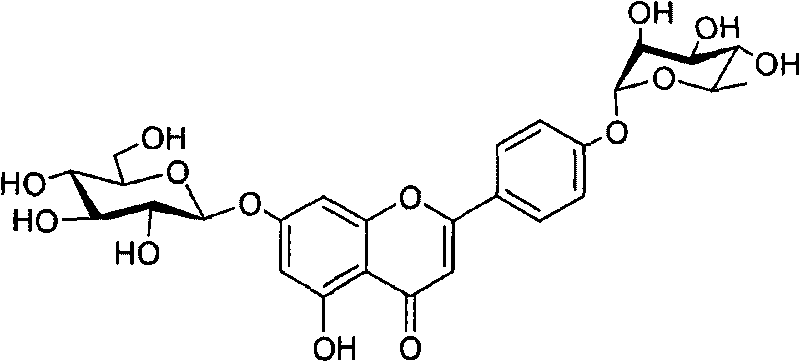Intermediate of flavonoid compound and preparation method and application thereof
A technology for flavonoids and compounds, which is applied in the fields of sugar derivatives, organic chemistry, drug combinations, etc., can solve the problems of low extraction efficiency, difficulty in meeting research applications, complicated and tedious operations for separating and extracting compounds of formula A, etc.
- Summary
- Abstract
- Description
- Claims
- Application Information
AI Technical Summary
Problems solved by technology
Method used
Image
Examples
preparation example Construction
[0071] Preparation of compound of formula M:
[0072] Reference Example 15, Synthesis of 7,4`-O-trihexanoyl apigenin (compound of formula M, R 1 For -CO(CH 2 ) 4 CH 3 )
[0073] Apigenin (Formula G, R 1 For -CO(CH 2 ) 4 CH 3 , 1.08g, 4mmol), 4-dimethylaminopyridine (155mg, 1.2mmol), triethylamine (2.6ml, 20mmol,) were dissolved in 10ml of dimethylformamide, and hexanoyl chloride (3.2ml, 22.8mmol), the reaction was stirred at 25°C for 8 hours (the apigenin was consumed by TLC), the system was diluted with dichloromethane, the organic phase was washed twice with saturated brine, dried over anhydrous sodium sulfate, filtered and collected the organic phase. After concentration, the crude product was recrystallized from ethanol to obtain a white solid (1.95 g, yield 88%).
[0074] 1 H NMR (400MHz, CDCl3) δ: 0.91 (m, 9H); 1.34 (m, 12H); 1.75 (m, 6H); 2.57 (m, 4H); 2.76 (d, 2H); 6.62 (s, 1H) ; 6.83(s, 1H); 7.26(d, 2H); 7.33(s, 1H); 7.88(d, 2H)
[0075] MS: 565 (M+H); 1151 (2M+Na)
[0076] ...
Embodiment 15
[0094] Example 15 Synthesis of-O-hexanoyl-7-O-benzyl-4'-hydroxyapigenin (compound of formula E, R 1 =-CO(CH 2 ) 4 CH 3 )
[0095] Formula F (n=4, 2g, 3.5mmol) was dissolved in a mixed solvent of 15ml of dichloromethane and 15ml of methanol. After cooling to 0°C, potassium carbonate (69mg, 0.5mmol) was added, and the temperature was raised to 20°C and reacted for 8 hours. (TLC shows that formula F is consumed), add 1mol / L hydrochloric acid and methanol to neutralize, remove the solvent by rotary evaporation, and separate and purify by silica gel column chromatography (dichloromethane:acetone=30:1) to obtain a pale yellow solid (1.52g, 90.3) %).
[0096] 1 H NMR(400MHz, CDCl 3 )δ: 0.92 (m, 3H); 1.39 (m, 4H); 1.46 (m, 2H); 2.67 (t, 2H); 5.31 (s, 2H); 6.49 (s, 1H); 6.73 (d, 1H) ); 7.06(d, 2H); 7.21(d, 1H); 7.36(m, 5H); 7.88(d, 2H), 9.02(s, 1H)
[0097] 13 C NMR(CDCl 3 )δ: 13.9, 22.3, 24.1, 31.3, 34.3, 99.9, 105.9, 108.9, 111.0, 116.1, 116.2, 122.2, 127.4, 127.5, 127.8, 128.7, 128.8, 13...
Embodiment 25
[0099] Example 25 Synthesis of -O-hexanoyl-7-O-benzyl-4'-hydroxyapigenin (compound of formula E, R 1 =-CO(CH 2 ) 4 CH 3 )
[0100] Formula F (n=4, 2g, 3.5mmol) was dissolved in a mixed solvent of 7.5ml of dichloromethane and 7.5ml of methanol. After cooling to -10°C, sodium carbonate (53mg, 0.5mmol) was added and the temperature was raised to 30°C. React for 10 hours (TLC shows that formula F is consumed), add 1mol / L hydrochloric acid and methanol to neutralize, remove the solvent by rotary evaporation, and separate and purify by silica gel column chromatography (dichloromethane:acetone=30:1) to obtain a light yellow solid (1.40 g, 83.2%).
PUM
 Login to View More
Login to View More Abstract
Description
Claims
Application Information
 Login to View More
Login to View More - R&D
- Intellectual Property
- Life Sciences
- Materials
- Tech Scout
- Unparalleled Data Quality
- Higher Quality Content
- 60% Fewer Hallucinations
Browse by: Latest US Patents, China's latest patents, Technical Efficacy Thesaurus, Application Domain, Technology Topic, Popular Technical Reports.
© 2025 PatSnap. All rights reserved.Legal|Privacy policy|Modern Slavery Act Transparency Statement|Sitemap|About US| Contact US: help@patsnap.com



